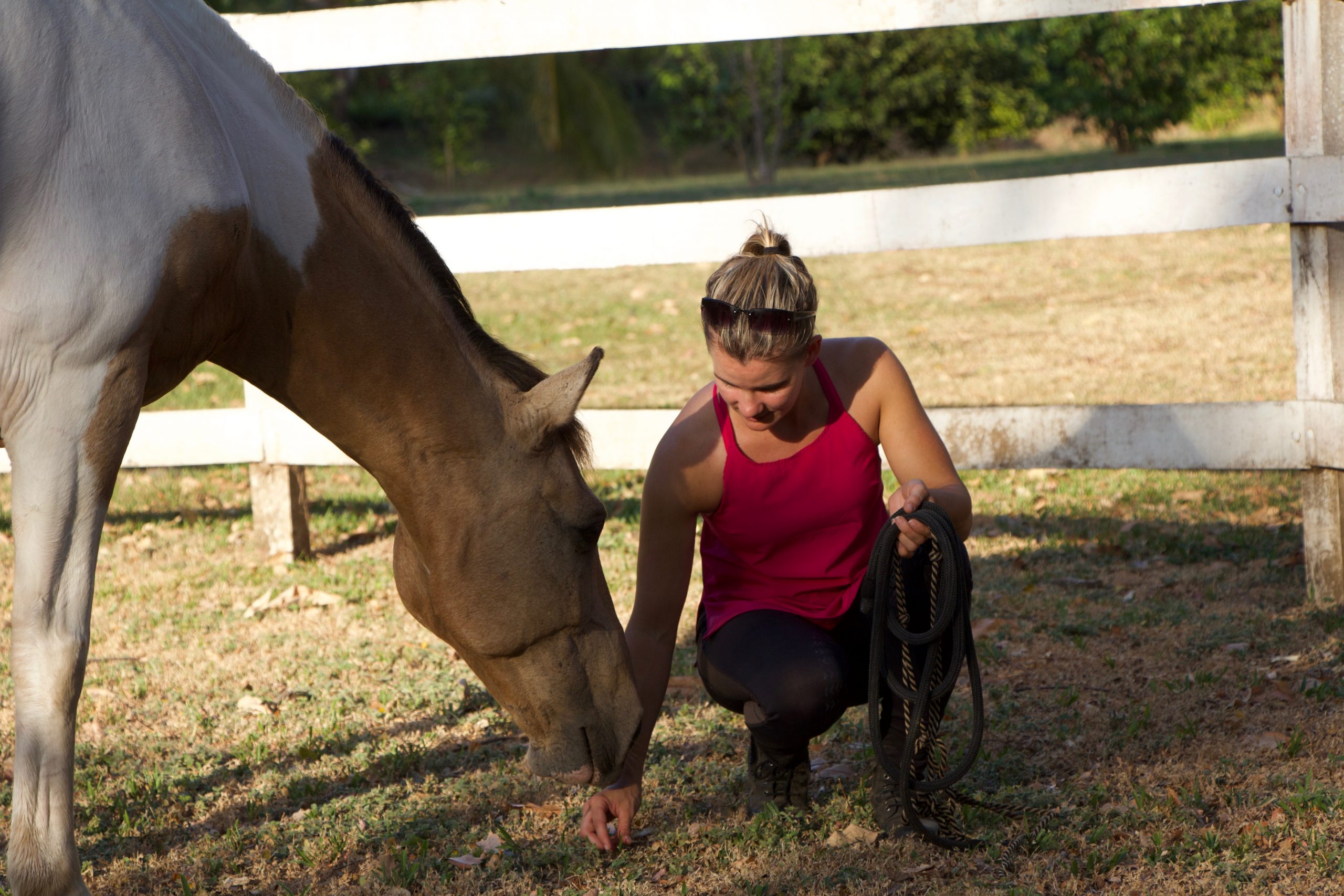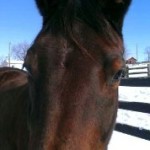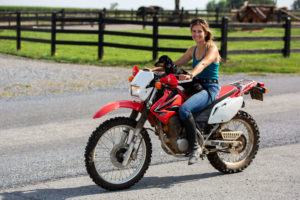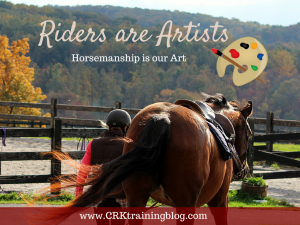How do you respond to challenge? When something is difficult, do you push forward, trying harder and giving 110%? Do you back off, perhaps looking for a reason to abandon the challenge altogether?
How do we know when we are pushing too much or trying too little? How do we find our own limits? What is right for one person is often not right for another, but how can we discover and honor our own limits?
These are questions that have been top of mind for me the past few weeks, as I just returned home from hosting several riding retreats in Costa Rica.

The retreats are wonderful – they are relaxing but challenging, we do a lot of riding, and there are many opportunities for learning and growth.
We begin each day of the retreat with a yoga session, then go into riding lessons, groundwork with the horses, and of course, spend time riding through the beautiful beaches and jungles of Costa Rica!
What is interesting is how the same challenges often come up through each part of the day. The challenges presented in yoga class may be different physically, for example holding “chair pose” a few breaths longer is a different challenge than riding rising trot, but the mental patterns we run upon encountering a challenge are usually very similar.
Heidi Blackman is our yoga instructor on the retreats, and each morning, in a calm, warm voice she brings our awareness to those mental patterns and guides us to consider approaching challenge in a different way.
Mental Patterns
Our brains are efficient machines. When the brain figures out a way of doing something, it tends to stick with that way, forming a pathway for the action, movement, or thought, and then repeating it with little conscious effort.
You have probably experienced this with the difficulty of changing an old habit in your riding, perhaps of leaning forward or turning your toes too far out.
We even have well known sayings to express the difficulty of change, such as “old habits die hard”.
Just as we form physical habits or patterns, in the way we sit, move, and stand, we also form patterns in our thoughts and responses.
Observing one’s thoughts is a challenge all its own, but noticing thought brings awareness to those stubborn, ingrained mental patterns.
When we are aware of our thoughts, we hold more power to change them, to control our emotions, and then to find and create better solutions to the challenge we are facing, whether that challenge is how far to push a particular yoga pose, managing feelings of anxiety riding an excited horse, or finding the words to speak up when a situation feels unsafe.
Here is where the important lesson from yoga applies. Yoga creates challenge through the difficulty of the various poses. The purpose of the yoga poses is not only to develop physical strength and flexibility, but also to observe the patterns of one’s mind.
To generalize, we tend to respond in one of two directions to challenge.
The first is struggle and strive, pushing harder, trying harder, giving 110% of our effort. If you identify with statements such as “pain is gain” or you don’t feel something is working until you can really feel it or clearly see the results, you probably fall into this pattern. We could call this over-achieving and I believe that many riders fall into this category because strivers or over-achievers are not stopped by challenge, they are driven by it.
But this is not always an appropriate pattern to have. Continually pushing through challenge can result in injury from doing things that are unsafe, it can end in burnout and frustration when even one’s most dedicated attempts come up short. Being stuck in a pattern of always pushing through can also mean blowing right by the solution, as solutions are often small shifts and are discovered by getting quiet and doing less.
The second pattern, the opposite of over-achieving, is giving up. Here we look for an excuse to not try anymore. It may be personal “I will never be able to be that flexible anyway”, or external, “it’s too windy to ride today”, or even in comparison to others, “she started riding years ago, I’ll never be able to do that…”.
In giving up, we save stressing ourselves, but we also miss out on the growth and learning that was available. We do not find the solution because we have come up with reasons to not even bother looking for it.
The answer is, of course, that neither of these patterns are always wrong or always right.
The key to responding better to challenge is to have awareness of your current pattern and be able to respond in a different way, challenging yourself, yet honoring your limits.
If It Feels Like Too Much It Is Too Much
An expression we often hear during morning yoga sessions as Heidi guides us through the class is “if it feels like too much it is too much”.
We are the only ones that can determine how much we are challenged by something, physically or mentally, and the only ones who can truly know if we need to push forward or back off.
We have to recognize how a challenge feels for us, regardless of how easy or difficult it may be for others. We are each a unique tapestry of experiences, skills, and knowledge.
In yoga class, holding a downward dog for 10 breaths may be a perfectly appropriate challenge for one person, while for another it could be a challenge bordering on physical risk, if, for example, the position is straining a wrist injury.
Picking up the canter even though one’s horse has been a bit fresh earlier in the ride, may be a good challenge for one rider, but going beyond the limit of skill for another.
Joining in on the trail ride may have been fine last week, but this week, after that fall that left you feeling anxious just thinking about walking your horse outside the arena gate, is too much challenge.

These examples may seem obvious written here, but in the context of being in a group where everyone else seems just fine, or with an instructor who repeats “just do it, you’ll be fine”, making the decision to listen to your own inner voice becomes more difficult.
“If it feels like too much, it is too much” – respect your own limits, regardless of where the limit may be for someone else or even where it was for you on a different day.
Make the Challenge Objective
Since we are the only ones that know how a challenge truly feels, we also have a tendency to make that challenge bigger or smaller than it is.
When we can attempt to take a look at our situation from a slightly more objective view, we can find perspective on the current state of the challenge as well as recognize when it changes. The change may be the level of anxiety you experience going down as you feel more confident, or it may be the physical strain we used to feel after one lap of rising trot lowering to just a small increase in breathing.
To find this more objective view, try rating your challenge, whether it is physical, causing discomfort in pain or in fatigue, or if it is a mental challenge, such as anxiety or fear. Assign a number from 1-10, 1 being no challenge at all, and 10 being the highest you could imagine.
As this challenge continues or returns, notice if any change is needed in its “score”. Has it become easier? More difficult? This will make it easier to decide how to respond and to respond in a way that is different than your normal pattern.
***
In the end, we all have our own path, we are all different in the speed with which we learn, in our comfort level with risk, in our willingness to push.
You are the only one who knows how you really feel, both physically and emotionally. You need to be the one to make the call when it’s too much, to speak up for yourself, to be comfortable being on your own individual journey.
* If you are interested in learning more about the mindset of riding, and specifically want to overcome anxiety or fear around riding, I have a resource that can help – click here to learn about my program Calm & Confident Rider.
***














16 Responses
I loved being with you in Costa Rica Callie, and yes, the Yoga was more challenging for me than the trail riding. I’m an older “downward facing dog” . I appreciate more than ever the education and insight you provide to all of us on a weekly basis. With gratitude, Kim
Thank you so much for your amazing perspective and insight.
Excellent article! I can honestly relate.
Great analysis and advice! I really like the putting a number to your discomfort idea….a way to gauge progress. Thank you!
Great article! Sometimes the biggest problem is getting yourself out of the “they will think I’m a wimp” mindset.
Amanda, it is up to us as riders to be honest not only with ourselves but also with our instructors about what we are comfortable and not comfortable with in the saddle and there is no shame in communicating those feelings to your instructor because just like Callie said in the title of this article, if it feels like too much, it probably is.
-Julia Burdy, CRK Training Community Manager
I can relate to this as a recent hack out was full of drama with a lively new to me horse ending up not being able to pull her up when cantering. Then in the school during a cantering pole session having to calm a fresh horse. Knocked my confidence for the first time
Mark, I’m really sorry to hear about your recent experiences, hopefully they gave you an opportunity to learn a skill to keep in your toolbox in case you need it with a future situation!
– Julia Burdy, CRK Training Community Manager
Callie is not only an extraordinary horsewoman but an excellent educator as borne out in her writings.
Love this article, Callie. Lots to think about. Thanks!
AS always, great insight and delivery of the content!! Well stated and great advise…!!
So glad too that you had time in Costa Rica… seems to be the place that many are visiting.
Celia, it is a wonderful place with wonderful people – we always have a great time! Perhaps you’ll join us sometime
– Julia Burdy, CRK Training Community Manager
I’d love to know more about this event. I looked on your site and don’t see when it occurs or how much it costs.
thanks,
Judy
We haven’t confirmed dates for 2020 yet – for more information send me an email at crktrainingvideos@gmail.com !
-Julia Burdy, CRK Training Community Manager
Hi Callie, as always I enjoy reading your advice. The old saying nothing beats a failure but a try is true. Bible scriptures often remind us that our challenges only come to make us stronger. If we find that a certain thing becomes too much it’s ok to let it go. Yet, we can rejoice in knowing that we had the ability and was not afraid to give it a try.
Really loved this article! Will have to read over again and again to fully grasp all that it contains! Thank you!